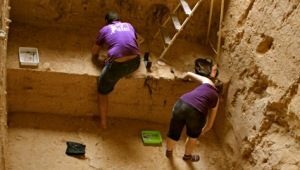
In a report co-authored by Michael Walker and colleagues of Spain’s Murcia University, scientists suggest that early humans who lived in the Cueva Negra (Black Cave) rock-shelter of southeastern Spain about 800,000 years ago used fire, and that they exhibited behaviors that indicated a cognitively sophisticated late early Pleistocene use of resources and tools in their environment. The detailed report is published in the upcoming Volume 15 of Popular Archaeology Magazine.
The rock-shelter, located in the face of a cliff overlooking the Quipar river and the small village of La Encarnación, became the subject of initial exploration by archaeologists in 1981. But full systematic excavations didn’t begin until 1990, when an archaeological team led by Walker and colleagues with the Murcia University Experimental Sciences Research Group undertook detailed investigation that continued for another 25 field seasons. What they uncovered were 5 meters of sediment containing late Pleistocene (somewhat before 780,000 years ago) finds, including hominin (early human, possibly H. heidelbergensis) teeth, a rich artifact assemblage, and an array of ancient flora and fauna remains that bespoke an ancient climate of warm, moist environmental conditions. Their analysis and interpretation of the finds may have, they maintain, important implications for early human behavior.
“The most important findings at Cueva Negra concern human activity,” write Walker and colleagues in their report. “Undoubted evidence of fire has been uncovered.”* They point to the evidence of sediment combustion, thermally altered chert and burnt animal bone found in a layer measured at 4.5 meters in depth.
But they qualify their interpretation.
“A fire-place is not a hearth,” the authors continue. “The Cueva Negra could have brought glowing brands left by a forest fire into the cave to establish and tend a fire where rain and wind would not put it out. They may well have been less afraid of fire outside than other animals they saw fleeing from it (which could have led them to play with fire in order to drive animals towards natural death traps, such as swamps, enabling dismemberment and roasting). This does not mean they could reproduce or control fire: there is a dearth of archaeological evidence for hearths or fire-pits before 0.5 Ma.”
Cueva Negra is not the only site that has evidenced early use of fire by early humans. For example, the site of Bnot Ya’akov Bridge in Israel has been claimed to show human control of fire some time between 790,000 and 690,000 years ago, and evidence has emerged at Wonderwerk Cave in South Africa for the use of fire by around 1 million years ago. There are also other sites showing this possibility in Africa and China. But Cueva Negra could be the earliest, if not one of the earliest, sites in Europe demonstrating this development.
Other findings suggested a clear mastery of material resources for survival. The assemblage of stone tool artifacts recovered (classified by the authors as “Acheulo-Levalloiso-Mousteroid”) showed evidence of the use of three different core reduction methodologies or sequences, and that natural stone resources were exploited as much as 40 km downstream from the site and 30 km upstream.
Concludes Walker, et al., “Research at Cueva Negra throws new light, including fire-light, on the cognitive versatility, manual dexterity, and technical aptitude of early humans ca. 0.8 Ma in S.E. Spain. They exploited their surroundings in a competent fashion that implies precise knowledge and accurate awareness of what was available for survival.”*
*Walker, Michael, et al., The Early Humans of Cueva Negra, Popular Archaeology, Vol. 15, June, 2014.
Cover Photo, Top Left: Excavations in progress at Cueva Negra. Courtesy Michael Walker and Murcia University
___________________________________________
Read about the most fascinating discoveries with a premium subscription to Popular Archaeology Magazine. Find out what Popular Archaeology Magazine is all about. AND MORE:
On the go? Purchase the mobile version of the current issue of Popular Archaeology Magazine here for only $2.99.
Popular Archaeology’s annual Discovery Edition eBook is a selection of the best stories published in Popular Archaeology Magazine in past issues, with an emphasis on some of the most significant, groundbreaking, or fascinating discoveries in the fields of archaeology and paleoanthropology and related fields. At least some of the articles have been updated or revised specifically for the Discovery edition. We can confidently say that there is no other single issue of an archaeology-related magazine, paper print or online, that contains as much major feature article content as this one. The latest issue, volume 2, has just been released. Go to the Discovery edition page for more information.




